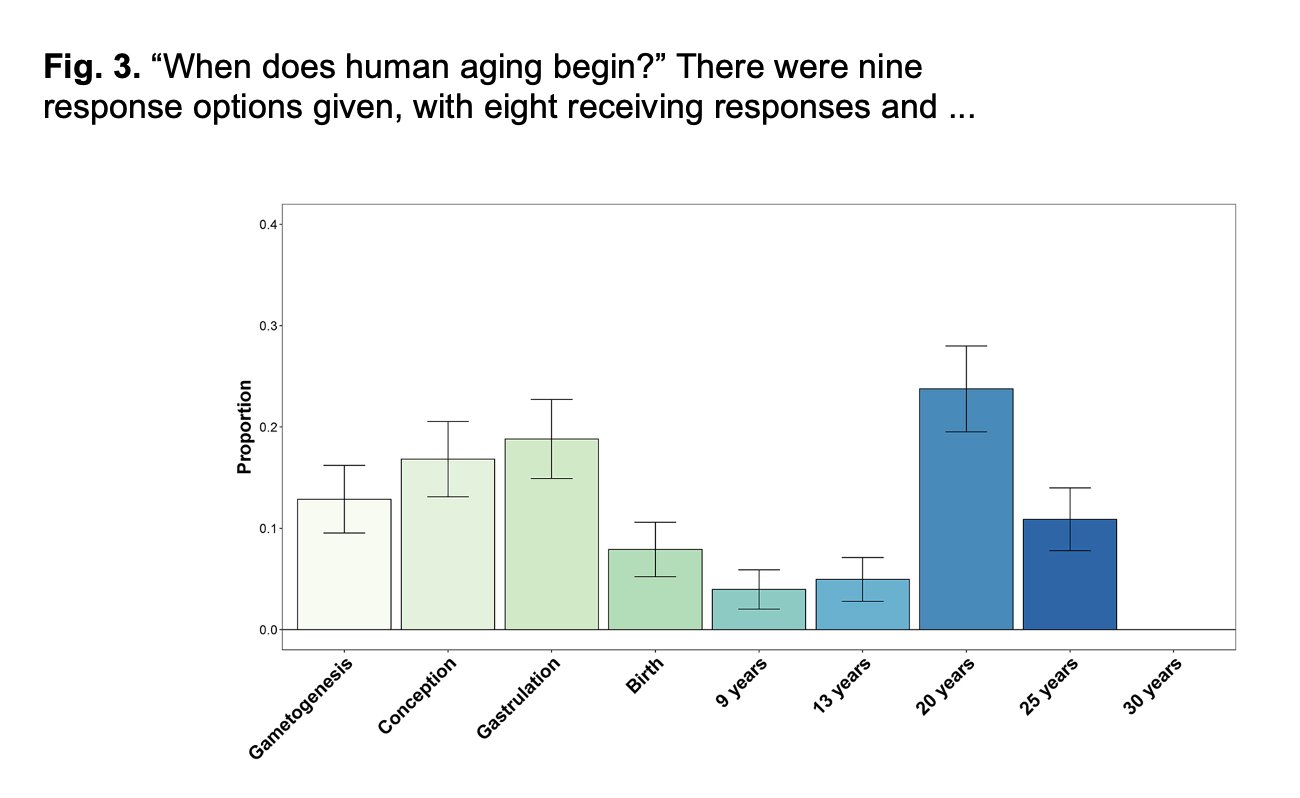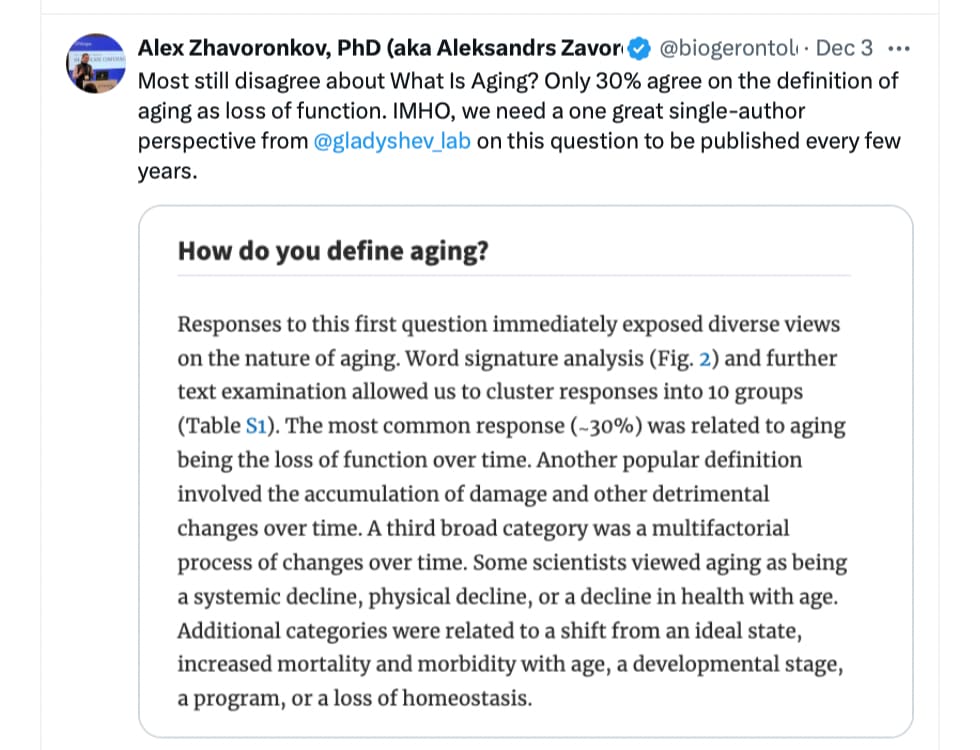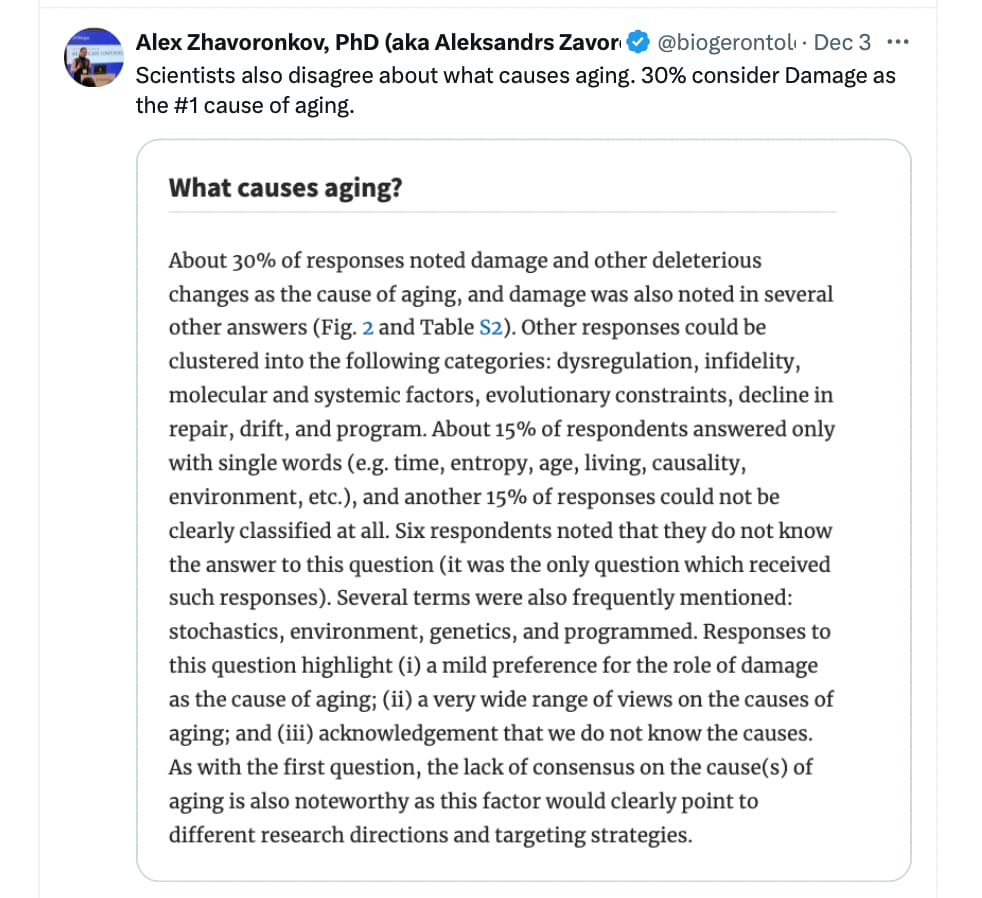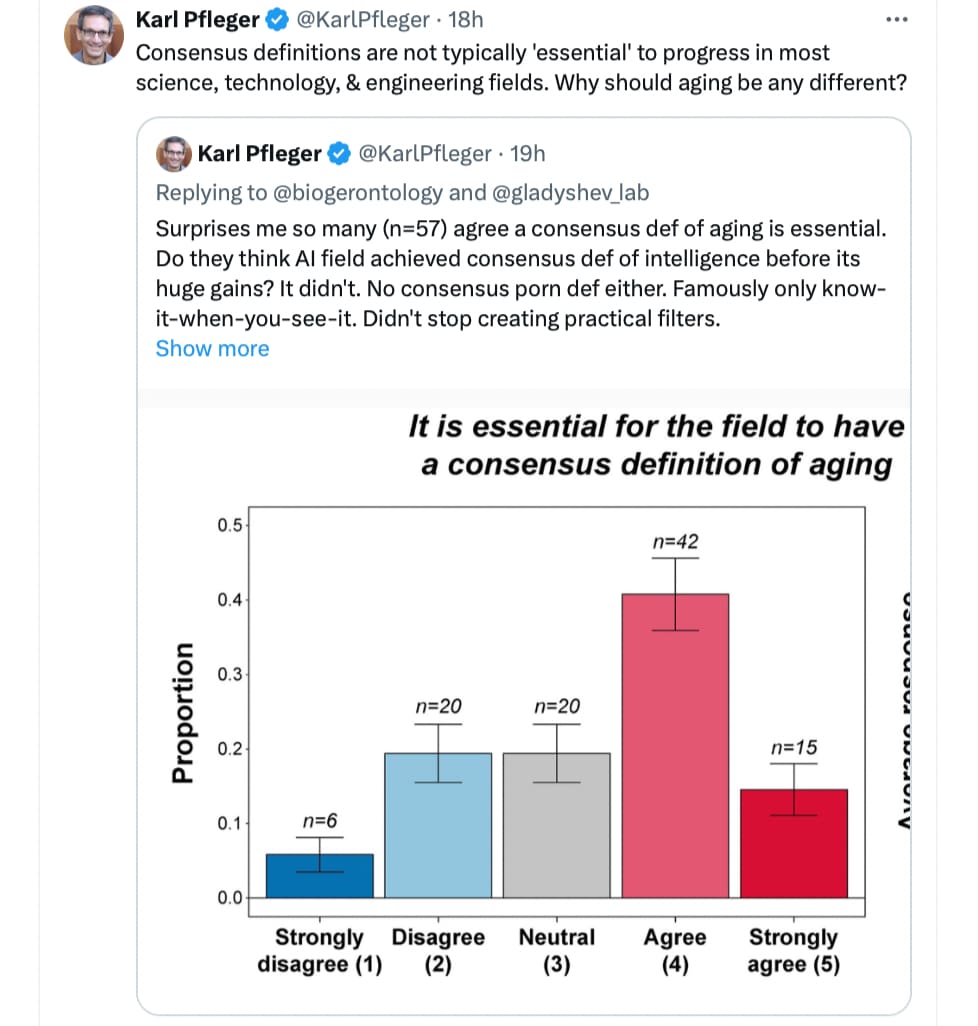This is based upon a nature paper which deals with the reponses to a survey.
“Scientists agree aging is a process and is inherently deleterious”. Powerful stuff.
Here is the original source
Some of the variance in perspective comes from poorly written questions but it is clear that the field is still searching.
Here are the many many responses to “what causes aging?” I guess it turns out that 12 Hallmarks of Aging is a step forward from this list
Here is my vote on the “what is aging” from below (I combined a few):
Accumulation of environmental insults (random, unavoidable, and self inflicted) leading to loss of mitochondrial function and cell / tissue homeostasis capability, leading to accumulation of metabolic and repair deficits and eventually to reduced functionality and resilience.
** Abbreviated answers to the question “What is aging?”, organized in 10 broad categories.
Categories, then the breakdown:
- Loss of function
- Accumulation of damage and other detrimental changes
- Multi-factorial process of changes over time
- Systemic decline
- Health and systemic decline with age
- Shift from an ideal state
- Increased mortality and morbidity
- Developmental stage
- Loss of homeostasis
- Program
- Loss of function
Decline in function (2)
Decline of function at every level
Decline in function or increase in risk of disease
Decline in functionality and resilience with time, culminating in organism failure
Gradual decline in function over time (2)
Gradual decline in functionality at the sub-cellular, cellular, and organism levels
Loss of function
Loss of function at organismal and cellular levels
Loss of physiological function
Loss of normal function
Loss of functional integrity with age
Loss of functionality
Loss of physiological tissue function
Loss of function from molecular changes that shift tissues out of homeostasis
Functional decline
Functional and systemic decline over time
Functional decline of organ systems
Progressive deterioration from optimal organismal function
Progressive deterioration of physiological function
Progressive functional decline caused by damage and characterized by increasing biological age
Progressive functional decline at the molecular, cellular, tissue, and organismal levels
Progressive loss of function on a cellular and systemic level
Age-associated dysfunction
Concomitant decline in the function of cell and tissue systems
Time-dependent decline of function
Deterioration of function with increasing time
Deterioration of tissue and organ function with time
- Accumulation of damage and other detrimental changes
Accumulation of damage
Accumulation of damage over time
Accumulation of damage that results in functional decline and mortality
Accumulation of errors
Accumulation in molecular damage which eventually contributes to increased risk of mortality
Accumulated stressors leading to dysfunction
Accumulation of stressors over time leading to systemic decline of cellular function.
Damage accumulation or entropy that causes loss of fitness and death
Damage accumulation and gradual decline of function performance
Systemic accumulation of detrimental changes at different levels of organism organization
Process of accumulation of molecular dysfunctions that manifests in a loss of fitness with time
Process of increasing deleterious change during an organism’s lifespan
Progressive accumulation of damage, leading to impaired function and increased death
Collection of damage over time
Buildup of myriad forms of molecular damage at the level of cells and higher-order systems
- Multi-factorial process of changes over time
Changes over time
Multi-factorial process of getting older
Multifactorial process leading to decline & death
Changes in biological state towards death
Cascading processes through which cellular programming changes
Lack of permanence of a desired somatic state
Progressive and intrinsic determination that occurs over time
Multi-factorial process that leads to the decline of physiological function
Irreversible changes happening during lifetime
Set of intrinsic processes that lead to functional decline
Effect of time on biological system
How an organism changes with time
Natural process of progressive biophysical change occurring in most living organisms
Age-dependent change (collapse) of the complex organic system
Fundamental change in systems biology of an organism with time
Getting old
Passing of time
Process of changes in organisms that occurs through time
- Systemic decline
Multisystem progressive decline
Systemic drift of an organism away from healthiness
Systemic tissue degeneration process
Systematic deterioration of all systems from the onset of puberty.
Systematic drift of an organism away from healthiness
Intrinsic physiological decline
Progressive loss of system integrity with the passage of time
Progressive decline in fitness due to damage accumulation
Intrinsic physiological decline
Disruption of system
Decline in critical systems maintaining cell and broader tissue functioning
- Health and physical decline with age
Decline of fitness with time
Decline in bodily function that is caused by the passage of time
Decline in physical or mental function
Decline in physical function
Degradation and decay of body function and physiological processes from the optimal level
Progressive decline in biological and physical health ultimately leading to death
Progressive decline in structure and function of a living organism
Physical decline with age
Continuous degradation of an organism as a whole over time
Mechanism of organism to stay with proper number
Intrinsic decline in health
Wear of the body
- Shift from an ideal state
Divergence of a system from a set of ideal states
Pseudo-random destructive process that is systemic
Product runs out warranty
Undefinable. But a culmination of various processes failing
Heritable dysregulation that is predictable by passage of time
Entropy
Inevitable process of life that all systems gradually failing
Whatever can be measured by a suitable clock
- Increased mortality and morbidity
Increased risk of morbidity after peak fertility
Expectation of remaining quality life years
Increased probability of death with increased aging
Biological process that underlies increased risk of mortality and disease
- Developmental stage
Process which causes an exponential increase in mortality rate after sexual maturity
Breakdown of the physiological processes that are initially present after development
Biological changes over time after maturity
Process of molecular, cellular and anatomical change in an animal occurring after puberty
- Loss of homeostasis
Gradual loss of homeostasis caused by damage accumulation at all organismal levels
Progressive loss of cellular homeostasis leading to physiological decay
Loss of effective coordination between biological processes present in the young body
- Program
Programmed biological process that eventually results in mortality
** Abbreviated answers to the question “What causes aging?”, organized in 10
broad categories.
- Accumulation of damage
Accumulation of damage (3)
Accumulation of damage over the lifetime of an organism
Accumulation of damage that decreases the ability to transcribe and send information
Accumulation of damage to macromolecules
Accumulation of damage over time and a decreased ability to repair that damage
Accumulation of molecular damage
Accumulation of toxic products and loss of viability in cells
Accumulation of deleterious damage and/or decline of the repair mechanisms
Accumulation of different forms of molecular and tissue damage
Accumulation of noise, errors, and over-corrections in the organic system
Unavoidable accumulation of deleterious changes
Damage (3)
Damage (of many types)
Damage (DNA mostly)
Damage, epigenetic drift and transcriptional noise
Damage accumulation and propagation
Damage accumulation and internal programs malfunctioning
Damage accumulation that undermines the integrity of biological structures/networks
Combination of molecular damage and diverged programs
Combination of accumulated damage, senescence, and hyperfunction
Stochastic accumulation of damage not repaired because of evolutionary constraints
Convergence of unspecific damage toward specific downstream effects
Inevitable accumulation of damage due to metabolism (imperfectness, heterogeneity).
Both random errors and inefficiency in necessary molecular processes
Cellular damage
Molecular damage and a decline in repair/resiliency mechanisms for said molecular damage
Progressive accumulation of cellular damage caused by imperfectness of biological systems
Culmination of many small damages, leading to eventual collapse
- Dysregulation
Multi-omic dysregulation via multiple mechanisms
Loss of homeostasis mechanism resulting in increased damage accumulation
Changes in transcriptional networks and chromatin state
Progressive dysregulation of cellular networks across various layers leading to loss of function
Dysregulation and damage
Epigenetic landscape disruption
Accumulation of environmental insults prevents cells and tissues from returning to homeostasis
Decline in functional resiliency to shock/stress
Removal of homeostasis preservation mechanisms
- Infidelity
Infidelity of biological systems
Imperfect systems. “Aging” is the default. Organisms evolve longevity.
Imperfect cellular maintenance
Derangements in maintenance that allow damage and errors to accumulate
Loss of fidelity in cellular programs
- Molecular and systemic factors
Small molecules, proteins
Multiple factors
Cellular stressors
Cellular senescence
Many factors, predominated by a combination of DNA damage and epigenetic changes
Hallmarks + ECM + mineralization + skeletal changes + psychology
- Evolutionary constraints
Nature of biological systems
Impossibility to handle an infinite number of stochastic events with a limited genetic information
Age-related decline in the force of natural selection
Entropy and lack of selective pressure to clean up the mess
Multifactorial depletion of resources s.a. stem cells
Extension of development program and programmed response to damage
Biology (inevitable breakdown of mechanisms, pathways and organisms)
- Decline in repair
Likely decline of various repair mechanisms
Multifactorial (e.g. reduced defenses and accumulation of insults)
Repair rate < damage rate
Accumulation of metabolic and repair deficits and reduced functionality
Loss of resilience potentially related to mitochondrial function that leads to damage accumulation
- Drift
Drift of cell state away from optimal baseline
Loss of genetic or epigenetic information, mainly coupled with cell replication
Changes to genome (especially epigenome)
Physical and chemical changes
Both random drift and/or maladaptive program (for organismal level)
- Program
Programmed biological process
Underlying (epi)genetic program
- Single word answers
Time (3)
Entropy (3)
Unknown (2)
Age
Stress
Gravity
Living
Causality
Dyssynergia
Environment
Senescence
- Other responses
I don’t know (2)
I don’t know unfortunately
Cycle of life
Intrinsic and extrinsic
Break the chemical balance
Different mechanisms in different organisms
Inflammation and immunodeficiency
Time + chemistry + thermodynamics + biological programming
Multiple causes including epigenetics
Combination of stochastic and programmed changes
Mixture of deterministic processes (over-drive of developmental processes) and wear-and-tear
Interaction of genes, environment, and time
Largely unknown; seems to be a role for genetics, environment, and stochasticity
Result of regenerative processes falling behind dissipative and pathological events
Environment, as the walls between the outer and inner “worlds” of any organism do not exist
Rate and mean set by genetics, variance from environment, inability of programs to maintain state
Interaction of germline/somatic genetic factors, innate/acquired epigenetic factors, environment, lifestyle
Genetically-mediated endogenous processes and responses to external stimuli that erode over time
Time causes aging ![]() the longer you live, the older you become
the longer you live, the older you become ![]()
These somewhat philosophical discussions, while interesting and may lead somewhere, are just that, philosophical.
For example the “damage” thing. That one implies that damage causes “aging” but what about healing? if you suffer damage, you need to heal it. So a broken healing system is the cause of aging. Healing what? and how?
I’m glad people much smarter and more educated have time for these debates ![]()
For me it come back to my 3 rules;
- does it work? are there enough studies to show it works in humans?
- can I do it now?
- if yes, do it. If no, move on to what I can do
I look forward to the day when age related decline is solved but I know for certain it won’t happen in my lifetime, so increasing healthspan remains my best option.
Fortunately there are more things that can help do that than I can count ![]()
I think there is a value in having a mechanism of aging which can be used to work on synergistic interventions. In practice I think people will accept the mechanism on a more consensual basis when it is seen to be effective to intervene via that mechanism.
The scattershot approach of testing interventions without a mechanism has the difficulty of the number of tests required and the fact that some interventions cancel each other out.
As you know I have myself identified what I think is the correct mechanism, but I accept that I need to prove this.
Aging is a designed program, a process which can stretch or shrink depending on individual choices.
@John_Hemming I agree that we need to understand mechanisms to really understand anything but the problem with “mechanism” is how hard it is to really understand biology and how easy it is to fool yourself with a logical sounding explanation.
Even if we could ignore how interconnected everything is in biology, the mechanics of simple biological processes involve chemistry, electricity, quantum effects…who is study biology at this level?
I think we are far from really doing more than guessing (educated guessing is good) and testing and finding stuff that seems to work. This is why I think the best approach is to focus on letting the body do its thing which evolved over a billion years to deal with the complexes of our world. Most of them anyway.
For myself, I think the best I can do is stop injuring my body (pollution, toxins, over consumption, metals, cumulative lifetime viral load, nutritional deficits) and stop signaling my body to adapt into dysfunctional phenotypes (sedentary, lack of light spectrum, poor circadian alignment, lack of mental/social stimulus).
What did I miss?
New commandment #12 (I already have a personal #11)
- Seek ye the Infinite Health Span.
My personal #11 is;
- Thou shall not believe thine own bullshit.
I stumble on that one LoL!
I think you need to consider how to avoid particularly damaging mitochondrial DNA and how to do quality control on mitochondria (as well as getting senescent cells to fundciton).
A lot of the things you do actually work in that way.
However, targeting the mechanism directly is easier as a route towards effective results.
Some people who went against consensus - Ignaz Semmelweis (handwashing to prevent puerperal fever), Barry Marshall and Robin Warren (Helicobacter pylori as the cause of ulcers), and Jonas Salk (the polio vaccine).
Well the consensus is not needed but the agreed on test for aging is needed to move the field forward. Further there is a test for intelligence - Turing test. With respect of current aging clocks are the first step but seems are not very reliable and with limited usefulness. That said as aging is systemic, I see combined physical and mental performance test including vision, hearing and physical appearance as good enough for now. Basically if you look and perform exactly like your 25 year old self, which can be easily tested with available tools, you are 25 or so. It doesn’t have to be super precise.
This is an argument for functional tests of aging. This is in fact Charles Brenner’s view. It is also my view.
Isn’t Turing test for machines rather than ppl? How can it apply for testing aging?
Sorry that it was confusing. Turing test is indeed meant for software/Ai to prove that it reached human level of intelligence. I brought it up as some aging researcher in a post I was responding to was stating that there is no such test for software ;hence, we don’t need a test for aging either to move the field forward.
@John_Hemming Thanks. No doubt my body already does this. But probably not as well as it used to when I was younger.
If my body is creating too much ROS (insufficient mitophagy, insufficient mitochondria biogenesis, too much glucose being fed into the engine) and/or not curing the ROS (melatonin, glutathione, etc), I should eat only what I need, exercise, get NIR, avoid toxins, avoid viruses, etc. to stop wrecking my bodies ability to operate properly.
Getting into your area, why does the body lack citrate such that insufficient ATP is available to make certain proteins (“long genes”?).
How do we unwreck what has been wrecked (degraded). Taking citrate doesn’t solve the problem (I recall you saying) but helps the proteins to be made (not fail to differentiate, and instead become senescent). Does that eventually unwreck the repair system or the energy making system? Does anything? Rapamycin, forced autophagy (periodic fasting/ FMD / CR / aerobic exercise)?
The mitochondria export citrate, but as they become less efficient they export less. Ideally they should be made more efficient, but a bodge is exogenous citrate.




